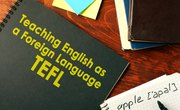The Grammar Translation Method (GTM) used in teaching English as a foreign language (TEFL) focuses on reading and writing. Language is taught through translation methods, contrasting and comparing the native tongue to the learned language. GTM focuses on sentence structure, grammar, vocabulary and direct translations of the native language to English. The method requires few resources to teach, normally just the use of textbooks or translated passages.
Reduced Teacher Stress (Advantage)
Resources for GTMs are easier to come by than other approaches and generally require less teacher involvement. Class activities or learning games are rarely necessary, as students are translating text to another language directly. Teachers who are not fluent in English (but fluent in the other language that the students primarily use) can teach English using this approach, as the emphasis is not on the spoken word but on translations. Communication between student and teacher is reduced with this method, which avoids misunderstandings and prevents language barriers that may occur in a method that focuses on teacher-student communication or verbal language learning.
Focus on Grammar, Sentence Structure and Word Meanings (Advantage)
Unlike a verbal approach to language learning, GTM focuses on the application of grammar and correct sentence structure. This is especially helpful in teaching students how to write and read in another language, allowing them to explore interchangeable words and phrases (i.e., different words for different tenses) more effectively than a verbal teaching method. The approach is also easily applied and can be less stressful on students; verbal teaching methods do not describe the application of grammar and sentence structure as effectively as GTM does. Word meanings are also easily learned through direct translation---a foreign word can be compared to the native language quickly. The method of comparing/translation of the learned language with a native language provides reference for students.
Learner Motivation and Participation (Disadvantage)
The GTM approach involves no learner participation and little teacher-student relationship. Students are required to learn from a textbook and use the same method throughout their learning. Because lessons using GTM are not interactive and engaging for students, they become more likely to lose interest in their subject and less motivated to learn. Furthermore, the method does not require students to participate in any activities or communicate with each other, so they will not learn how to use the language in a real-life conversation or situation and will only know how to translate one language to another.
Unnatural and Inaccurate Pronunciation (Disadvantage)
As children, people generally learn how to speak before they learn how to write and read. In the GTM approach, this natural learning method is reversed. Students are only taught how to read and write the language. This can affect how they learn to speak the learned language. The mere application of grammar and sentence structure cannot adequately prepare them for realistic conversations or verbal communication, as no emphasis is given to spoken language in the GTM approach. Translations may also be inaccurate, as it is not always possible to simply translate one word or phrase accurately to another language (for example, the translation of "computer" in English to Latin is not possible, as there is no Latin word for computer).
Related Articles
References
Writer Bio
Victoria Gorski has been a freelance copywriter since 2005, producing articles for small businesses, newspapers and magazines, as well as creating marketing material. She also publishes material for literacy communities and regional newspapers, such as the "MEN" and "Bolton News." Gorski is pursuing a Master of Arts in creative writing and a postgraduate certificate in education.











